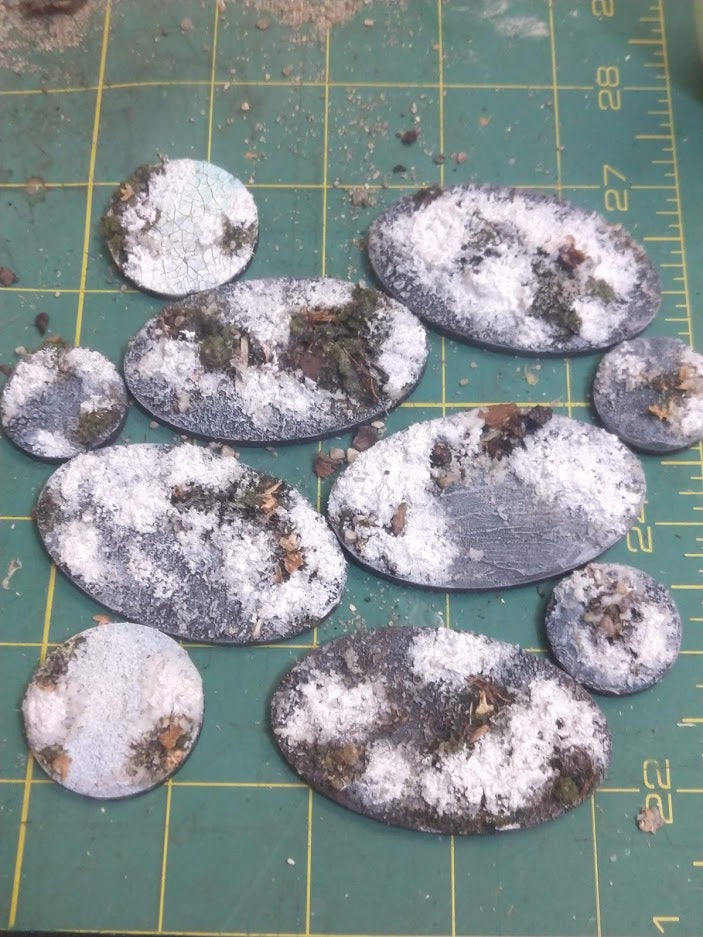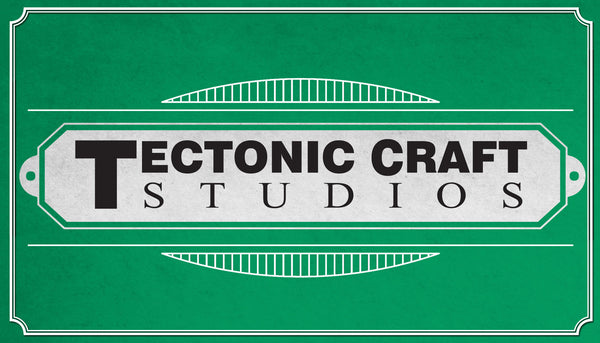
Animosity Campaigns II: Quick & Dirty Bykaal Basing
Share
Welcome to Homebrew hobbycraft.
For those of you unacquainted there is currently an ongoing global narrative campaign for Age of Sigmar called The Animosity Campaigns II: The Burning Winter. Taking place in the frozen underworld of Lake Bykaal, Six Factions fight for control of the lake and the secrets held within. Find more information here:
https://animositycampaigns.com/about/
There are 5 ways to contribute for your faction each week, and I'm here today to help you all get hobbying quickly and effectively.
-bases for your terrain and/or models
-course and fine sand
-course and fine sawdust
-course and fine flock: dark brown, dark green, light grey, dark grey, and snow flock.
-wood and tacky glue
-wood putty
-blues, greys, beiges, greens, and black and white paints.
-modge podge
-acrylic matte medium
-scenic pumice paste
-3/8" dark brown cork tiles
-paper plates, paper mixing cups, coffee stirrers, and some trash paintbrushes.
First thing we want to do is get the bases for our models or terrain. For basing terrain I like to use laser cut mdf because it is thin, sturdy, and affordable...also I have literally hundreds of pounds of it. You can find these plenty of places online, at your local makerspace or my favorite place to get them right here and here.
Now the big picture takeaway here is that there are few things, especially in the hobby/craft world, that are a one and done process (except of course contrast, but that's for another day). For this we are going to follow a bit of wisdom we can all apprecaite: two (or more) thin coats. I'll show you.
I always use wood glue when basing my models. If it's strong enough for carpentry it's strong enough for our models. Here's are few different ways you can apply the it. When using wood glue to assemble models I say just to use a touch. When it comes to basing we can be a bit more generous.
Next I add in some basing materials. For 2 I started with course sand and the last I started with fine sand.
Wait a little bit for that to dry. Wait at least a minute for it to set, longer if you used a lot of glue. Next add glue to the parts you didn't cover, parts you with to build up, or parts you wish to use as accent and apply the basing material of choice.
By using a 2(or more) step process you can get a more varied, believable look to your bases. If you start with course sand (or sawdust, for a more grassy look) and then use the fine sand (sawdust) it will fill in between the pieces of the larger grade sand and give a fuller and more varied coverage.
Pumice paste can be used as snow cover or as basing material, depending if you put it on before or after priming. Wood putty is a good start to making a varied ground cover as it can be used to create several degrees of smooth or roughness.
We want these to look like this at this point
Not like this
So now we hit them with some Dark Brown Ultra-matte camo primer
Now we grab some paints- I get a lot of greys, blue-greys, brown-beiges, and green beiges... and of course some black and white for mixing highlights or shadows if we want, but we can skip this for now.
Here is one paint of bluish grey (greatcoat grey from the above, but other brands identify this with wolves or just bluish grey). You can see that some of the sawdust is scraping off from the brushwork. This happened because I did not modge-podge it afterwards to seal it in place. It will continue to degrade as I paint but don't fret. I'll show you how to fix it up in the end.
Next is a rough coat of medium grey over that.
Another lighter grey
Next I hit the scrub with a wet-brush of necrotic flesh/green beige then a highlight of ivory
Next I added a little bit of watered down blue wash in various spots to add some contract then hit it again with a white/grey drybrush
Next I made 3 separate mixes for my ground cover palettes:
-a green and foliage filled composty-like one (forest floor/wilderness cover mix, dark green fine scrub from woodland scenics, fine soil flock from woodland scenics, leaf litter from shadows edge scenics). I added in some extra medium green medium underbrush in there too
-a rubble and rock filled one (fine and course sand, bits of cork, bits of heavy balast from woodland scenics)
-a generic winter scrub one (grey sawdust flock, soil flock, leaf litter)
For the foliage heavy mix, I put a dab of wood glue on the paper plate and steadily mixed in the foliage mix to make scrub. When I got them into nice and easily place-able clumps I put them aside to dry.
After those had started drying- you can tell when they are a little bit sticky still but also partiall dry, I generously applied wood glue to the portions of the painted bases and popped those suckers onto the glue with space around to add some of the various mixes.
At this point go nuts. I'd say have a few practice bases ready to test things out on so you can get your best results for the bases your models will go on. Be sure to leave room for the feet!
Sometimes you need to re-apply glue to where you're applying your underbrush. Feel free to really load up. When using wood glue on wood I say to go very sparingly. Since there is so much irregularity and surface area, a good bit is necessary to make sure it all connects. Be wary, the more you use the longer it will take to dry.
After you glue down scrub, use an old paint brush to pull some glue out so you can blend some of your cover mix to ground it a bit.
Here are some winter bases before we add snow effects!
To make our snow mixture I put 1 part grey sawdust flock and 2 parts snow flock into a paper mixing cup (ketchup cup) and used a coffee stirrer to mix in modge podge. This gives us a nice mix of color in the snow- like it's been there a while and the modge podge will give the edges a bit of meltiness/frozen finish.
For more melty snow I added more modge-podge. For a more frozen/crusted look you can use less.
After that you apply it generously with your stirrer-stick and spread it across the base with an old paint brush.
For the final touch- I mixed white pumice paste and clear matte medium in a 1:1 ratio. It will come out a bit brighter than the other parts of what you have added. I put a modest blob on top of existing (and dried) snow effects and then wet my brush to blend them into the rest of the effectcs.
With a little patience and brushwork all things can be made right.
Ok! A million pictures and 10,000 ingredients later but I think this is pretty solid effect. Thanks for checking this out. Let me know if you give it a try!
